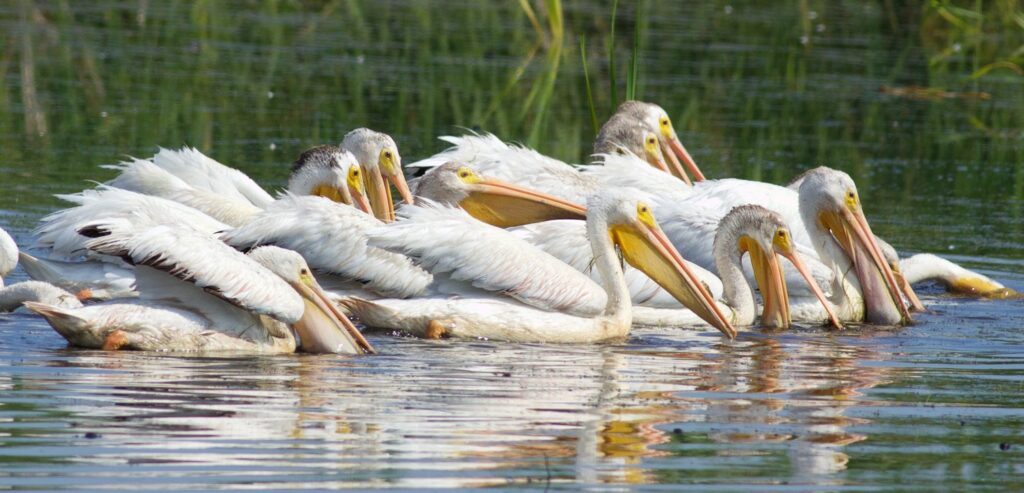As I drove home from a week at a lake, catching few fish, I saw a group of fish-eating birds circling overhead – pelicans. Were the Pelicans mocking me? Probably not, but I stopped to admire these large, seemingly ungainly waterbirds which are so adept at piscivory. Known for their unique long beaks and large throat pouches, eight species of pelicans are found in various parts of the world.

Belonging to the order Pelecaniformes, along with ibises, spoonbills, herons, egrets, the Hamerkop, and Shoebill Stork, pelicans are in their own family, Pelicanidae.
Species :
-
- American White Pelican (Pelecanus erythrorhynchos): Found in North America.
- Brown Pelican (Pelecanus occidentalis): Native to the Americas and the Caribbean.
- Peruvian Pelican (Pelecanus thagus): Found on the Pacific coast of South America.
- Great White Pelican (Pelecanus onocrotalus): Occurs in parts of Europe, Asia, and Africa.
- Pink-backed Pelican (Pelecanus rufescens): Found in Africa and Arabia.
- Spot-billed Pelican (Pelecanus philippensis): Native to Southeast Asia and India.
- Dalmatian Pelican (Pelecanus crispus): Occurs in parts of Europe and Asia.
- Australian Pelican (Pelecanus conspicillatus): Found in Australia, New Guinea, and parts of Indonesia.
Pelicans are large birds, ranging from 4 to 6 feet (1.2 to 1.8 meters) in length and typically weigh between 11 to 33 pounds (5 to 15 kilograms), the largest being the Great White Pelican; wingspans range from 7 to 11 feet (2 to 3.5 meters).Their long straight beak with a hook at the tip may reach up to 18 inches (45 centimeters) in length. They have a large, expandable throat pouch that can hold several liters of water. Their feathers are mostly white, with varying degrees of gray, brown, or black on their wings and back. Some species also have distinctive breeding plumage.
Brown and Peruvian Pelicans feed by diving from the air, scooping up fish underwater and draining their gular pouch before swallowing the enclosed fish. To protect their neck from injury, they stiffen the surrounding muscles as they dive and reflex their wings straight backwards, air sacs under the skin around their neck and breast area inflate before the bird hits the water’s surface, and the gular pouch behaves like an air bag: the instant a bird’s jaws open under the water, its forward momentum is slowed.
Or pelicans may utilize cooperative feeding. Groups of 10-20 pelicans work together while swimming to herd small schooling fish into a circle of birds or towards shore where they can be easily captured. This behavior can start when the presence of pelicans attracts more pelicans to the area and a group forms. The pelicans begin to swim toward each other, closing in on the fish. Once one pelican strikes at a fish in the dense school, the other birds begin to feed.
Capturing prey underwater could impair breathing but Pelicans have nasal openings sealed off and hidden beneath the beak’s horny sheath. The hidden nostrils house special glands which remove excess salt from the bird’s blood stream. This is an essential adaptation as many pelicans ingest seawater.
We have many American White Pelicans that migrate through Oregon during the fall. I counted 11 of them in a lake near my home in September. It is always fascinating to watch them feed in groups as you described. They are such massive birds and I look forward to seeing them every year!
“A wonderful bird is the pelican
Its bill can hold more than its belly can”
– Ogden Nash
Pingback: The Pelicans – Ornithology - Vetezi